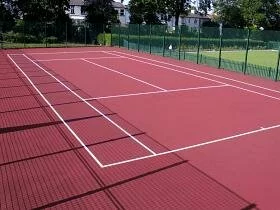This covers a multitude of sins! But can be broken down to the main question as to “why has the court deteriorated?”:-
An English tennis court has a macadam surface called “open textured”, which allows the water to drain “through” the surface, rather than “off” it. This open textured surface is made so the “grains” of macadam are only held together by the bitumen around each of those “grains”.
Over the years, the bitumen weathers, and goes hard and brittle. If there is no paint on the court to protect these “grains”, then they will eventually break away from each other. This is called distressing, and is very noticeable in those areas that have moss on the court, or where sap has dripped onto the court from overhanging trees branches.
Being a perfectionist, Richard has over the years, developed and introduced products and techniques that in many cases, have enabled many old courts to become new again without the cost of resurfacing.
When a court has been laid (see Richard’s description in Resurfacing or see the FILM of how he carries this out) – The court should have been laid by hand, and there may have been the odd larger stone, or tree twig that may have become caught up in the macadam being laid.
Over 5 years (or when the court is due to be powerwashed), the twigs and larger stones – because they won’t support paint on them, will be exposed.
These are dug out and removed. The holes are then filled with cold rolled asphalt. If weeds have grown through the court surface, these are also removed, weedkiller placed in the hole, and again filled with cold rolled asphalt.
For those distressed areas, where the top grains have lifted out, there is unfortunately nothing that can be done. Normally they are more noticeable at the back or sides of a court. Once it occurs in the main play area, and affects player safety as well as ball control, then the court will need resurfacing.
